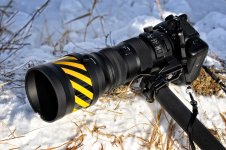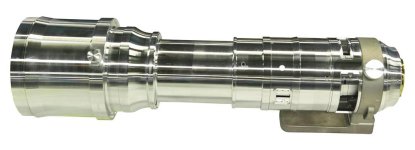Rob Bye
Senior Member
This past weekend I put my new Sigma 150-600mm lens through its paces, covering a sports event for the first time.
Despite the fact I already own the Tamron counterpart to this lens, I ordered this Sigma the moment my dealer began accepting preorders. I can’t speak about this Sigma lens without mentioning how pleased I’ve been with the performance of my Tamron.
The Tamron is a fantastic lens, delivering very good image quality. As a sports photographer, I’ve long wished for affordable lenses, like this, which would allow me to capture tightly composed images, even though, for whatever reason, I couldn’t get closer to the action.
As good as the Tamron 150-600mm is, it lacks that Nth degree of sharpness, wide open, and at maximum focal length. Images look really nice, but at 100% crop, I could always see detail missing in such things as the fabric of a sports jersey, or on the texture of a football. No big deal. The mere fact I was even able to capture these long-range images, more than compensated for any less than perfect optical performance.
When news came that Sigma was going to offer a similar lens, but with the promise of even better performance, I got very interested. Even at an extra thousand dollars, I was willing to pony-up, for whatever extra percentage of performance I could gain. That the Sigma also offered enhanced weather sealing, a number of extra features, and tougher construction, further cemented my intent to buy.
I’m sure you’ve already heard it stated: the Sigma is a beast! The Tamron is nearly the same overall size, but the Sigma weighs a lot more. The Tamron tips the scales at a little under two kilos. The Sigma weighs-in at closer to three kilos. A bunch of the Sigma’s extra mass is centred toward the front-end of the lens. It honestly feels like Sigma took a big, heavy-duty aluminium pipe, and straight poured optical quality glass into it. Judging by the weight, there seriously cannot be much air gap inside this lens.
There’s no question, the Tamron has nice balance - by itself, with a camera attached, or on a monopod. It’s an easy package to live with. The Sigma is not quite as easy to live with. I’m a big, burly guy, but just holding the Sigma has, at times, made me wonder if this might not be too much lens for me to be dragging around big sports venues. I’m not as young as I used to be. :moody:
Once at this weekend’s event, I never paid the Sigma’s size, weight, or balance the slightest bit of attention. I was only thinking about all the images I could take, now that I had enough lens to capture them. Finally!

Ice oval racing is like Formula 1 on a huge, frozen, oval shaped track. The top level sleds can sprint to speeds of about 170 km/h. They drift through the turns, in order to keep their speed up. Our track in Beausejour, 100 kilometres northeast of Winnipeg, is the largest of its kind in the world.
Covering this event the past decade, the challenge to me has been capturing the action across the immense width of the track. From the ideal photo position, outside of turn two, to where the peak action is happening, inside turn one, is a distance of about seventy metres. As it so happens, 600mm is the ideal focal length for that particular shot.

Now, I wish I could tell you I’d given the Sigma 150-600mm a full and exhaustive test, and then compared its performance to that of Tamron’s big lens. I tried. I tried my hardest to do all that, but the conditions were against me.
First of all, the light was not very good. These sorts of lenses need plenty of bright sunshine in order to deliver peak performance. At this time of year, in the frozen North, we don’t get many hours of daylight. Even when the sun is shinning, it always looks like we’re approaching sunset, as the sun is barely above the horizon.
The second issue I had to contend with was the cold. I’ve tested both the Tamron and the Sigma in temperatures as low as -30C. They worked just fine. In fact, I’ve seldom encountered any good quality camera gear that wouldn’t work all the way down to -45C, the point where I’ll quite working. :miserable: No the temperature last weekend was no worse than -15C, which counts as a lovely day around here. The problem was that, in that particular temperature range, frozen exhaust gasses from the sleds, and “ice dust” from their skis and tracks, tends to hang, suspended in the air. From seventy metres away, there can be a lot of ice crystals between me and my subject.
Thirdly, I had clients to satisfy, which meant equipment testing had to be a secondary consideration. I did have the Tamron with me, but I only used it for a short period of time. A proper showdown between it and the Sigma will have to wait until another day.
The images I did capture allow me to conclude the Sigma is a superb lens - as good as I’d hoped it would be. At full 600mm, and wide-open aperture, it delivered nice images, with crisp clarity in the fine details. Contrast and colour were excellent, as well. Continuous auto focus worked just fine, and the lens had no problem tracking the sleds. I had high hopes for this lens, and I’m not disappointed.

Additional thoughts:
- I used FocusTune software to calibrate each of my camera bodies to each lens. The Sigma needed only minor calibration to match up with my D7100 and my D300. In the future, I’ll use the USB dock to tune the Sigma over a wider range of focal lengths.
- With a smaller D7100 attached to the lens, and with me wearing snowmobile gloves, I found it difficult to properly grasp the camera. There’s only a limited gap between the Sigma’s wide outer barrel and the D7100’s grip. Having the battery grip under the camera allowed me to get a grip with my pinky finger. I’d imagine it’ll be the same for anyone using this lens with a smaller DSLR, like the D610, or a D750.
- I always use a sturdy monopod with these lenses. This weekend, I chose my aluminium Manfrotto 681B. In extremely cold weather, I’d recommend carbon fibre, because it won’t transmit the cold to your hands as much.
- With glove on, it was very difficult to operate the switches on the side of the Sigma. That’s not usually as much of a problem with my Nikon lenses. I believe it’s just that the Sigma switches are stiffer to operate than what I’m used to.
- I don’t care about the focus ring, but having the zoom ring direction reversed is annoying.
If you have any questions, I'll do my best to answer them...
Despite the fact I already own the Tamron counterpart to this lens, I ordered this Sigma the moment my dealer began accepting preorders. I can’t speak about this Sigma lens without mentioning how pleased I’ve been with the performance of my Tamron.
The Tamron is a fantastic lens, delivering very good image quality. As a sports photographer, I’ve long wished for affordable lenses, like this, which would allow me to capture tightly composed images, even though, for whatever reason, I couldn’t get closer to the action.
As good as the Tamron 150-600mm is, it lacks that Nth degree of sharpness, wide open, and at maximum focal length. Images look really nice, but at 100% crop, I could always see detail missing in such things as the fabric of a sports jersey, or on the texture of a football. No big deal. The mere fact I was even able to capture these long-range images, more than compensated for any less than perfect optical performance.
When news came that Sigma was going to offer a similar lens, but with the promise of even better performance, I got very interested. Even at an extra thousand dollars, I was willing to pony-up, for whatever extra percentage of performance I could gain. That the Sigma also offered enhanced weather sealing, a number of extra features, and tougher construction, further cemented my intent to buy.
I’m sure you’ve already heard it stated: the Sigma is a beast! The Tamron is nearly the same overall size, but the Sigma weighs a lot more. The Tamron tips the scales at a little under two kilos. The Sigma weighs-in at closer to three kilos. A bunch of the Sigma’s extra mass is centred toward the front-end of the lens. It honestly feels like Sigma took a big, heavy-duty aluminium pipe, and straight poured optical quality glass into it. Judging by the weight, there seriously cannot be much air gap inside this lens.
There’s no question, the Tamron has nice balance - by itself, with a camera attached, or on a monopod. It’s an easy package to live with. The Sigma is not quite as easy to live with. I’m a big, burly guy, but just holding the Sigma has, at times, made me wonder if this might not be too much lens for me to be dragging around big sports venues. I’m not as young as I used to be. :moody:
Once at this weekend’s event, I never paid the Sigma’s size, weight, or balance the slightest bit of attention. I was only thinking about all the images I could take, now that I had enough lens to capture them. Finally!

Ice oval racing is like Formula 1 on a huge, frozen, oval shaped track. The top level sleds can sprint to speeds of about 170 km/h. They drift through the turns, in order to keep their speed up. Our track in Beausejour, 100 kilometres northeast of Winnipeg, is the largest of its kind in the world.
Covering this event the past decade, the challenge to me has been capturing the action across the immense width of the track. From the ideal photo position, outside of turn two, to where the peak action is happening, inside turn one, is a distance of about seventy metres. As it so happens, 600mm is the ideal focal length for that particular shot.

Now, I wish I could tell you I’d given the Sigma 150-600mm a full and exhaustive test, and then compared its performance to that of Tamron’s big lens. I tried. I tried my hardest to do all that, but the conditions were against me.
First of all, the light was not very good. These sorts of lenses need plenty of bright sunshine in order to deliver peak performance. At this time of year, in the frozen North, we don’t get many hours of daylight. Even when the sun is shinning, it always looks like we’re approaching sunset, as the sun is barely above the horizon.
The second issue I had to contend with was the cold. I’ve tested both the Tamron and the Sigma in temperatures as low as -30C. They worked just fine. In fact, I’ve seldom encountered any good quality camera gear that wouldn’t work all the way down to -45C, the point where I’ll quite working. :miserable: No the temperature last weekend was no worse than -15C, which counts as a lovely day around here. The problem was that, in that particular temperature range, frozen exhaust gasses from the sleds, and “ice dust” from their skis and tracks, tends to hang, suspended in the air. From seventy metres away, there can be a lot of ice crystals between me and my subject.
Thirdly, I had clients to satisfy, which meant equipment testing had to be a secondary consideration. I did have the Tamron with me, but I only used it for a short period of time. A proper showdown between it and the Sigma will have to wait until another day.
The images I did capture allow me to conclude the Sigma is a superb lens - as good as I’d hoped it would be. At full 600mm, and wide-open aperture, it delivered nice images, with crisp clarity in the fine details. Contrast and colour were excellent, as well. Continuous auto focus worked just fine, and the lens had no problem tracking the sleds. I had high hopes for this lens, and I’m not disappointed.

Additional thoughts:
- I used FocusTune software to calibrate each of my camera bodies to each lens. The Sigma needed only minor calibration to match up with my D7100 and my D300. In the future, I’ll use the USB dock to tune the Sigma over a wider range of focal lengths.
- With a smaller D7100 attached to the lens, and with me wearing snowmobile gloves, I found it difficult to properly grasp the camera. There’s only a limited gap between the Sigma’s wide outer barrel and the D7100’s grip. Having the battery grip under the camera allowed me to get a grip with my pinky finger. I’d imagine it’ll be the same for anyone using this lens with a smaller DSLR, like the D610, or a D750.
- I always use a sturdy monopod with these lenses. This weekend, I chose my aluminium Manfrotto 681B. In extremely cold weather, I’d recommend carbon fibre, because it won’t transmit the cold to your hands as much.
- With glove on, it was very difficult to operate the switches on the side of the Sigma. That’s not usually as much of a problem with my Nikon lenses. I believe it’s just that the Sigma switches are stiffer to operate than what I’m used to.
- I don’t care about the focus ring, but having the zoom ring direction reversed is annoying.
If you have any questions, I'll do my best to answer them...

